key TOYOTA RAV4 2022 Owners Manual
[x] Cancel search | Manufacturer: TOYOTA, Model Year: 2022, Model line: RAV4, Model: TOYOTA RAV4 2022Pages: 748, PDF Size: 22.93 MB
Page 1 of 748
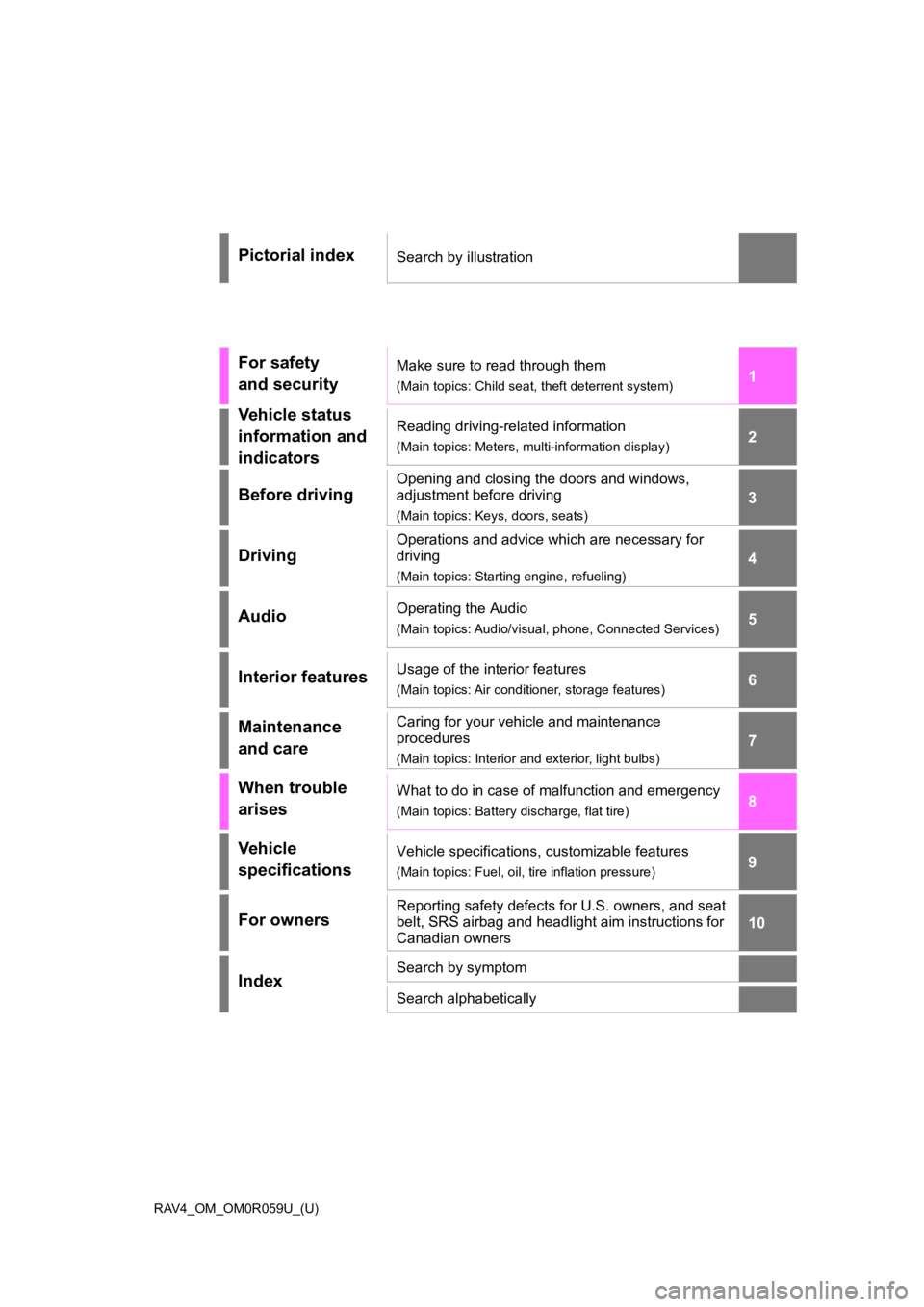
RAV4_OM_OM0R059U_(U)
1
2
3
4
5
6
7
8
9
10
Pictorial indexSearch by illustration
For safety
and securityMake sure to read through them
(Main topics: Child seat, theft deterrent system)
Vehicle status
information and
indicatorsReading driving-related information
(Main topics: Meters, multi-information display)
Before driving
Opening and closing the doors and windows,
adjustment before driving
(Main topics: Keys, doors, seats)
Driving
Operations and advice which are necessary for
driving
(Main topics: Starting engine, refueling)
AudioOperating the Audio
(Main topics: Audio/visual, phone, Connected Services)
Interior featuresUsage of the interior features
(Main topics: Air conditioner, storage features)
Maintenance
and careCaring for your vehicle and maintenance
procedures
(Main topics: Interior and exterior, light bulbs)
When trouble
arisesWhat to do in case of malfunction and emergency
(Main topics: Battery discharge, flat tire)
Vehicle
specificationsVehicle specifications, customizable features
(Main topics: Fuel, oil, tire inflation pressure)
For ownersReporting safety defects for U.S. owners, and seat
belt, SRS airbag and headlight aim instructions for
Canadian owners
IndexSearch by symptom
Search alphabetically
Page 2 of 748
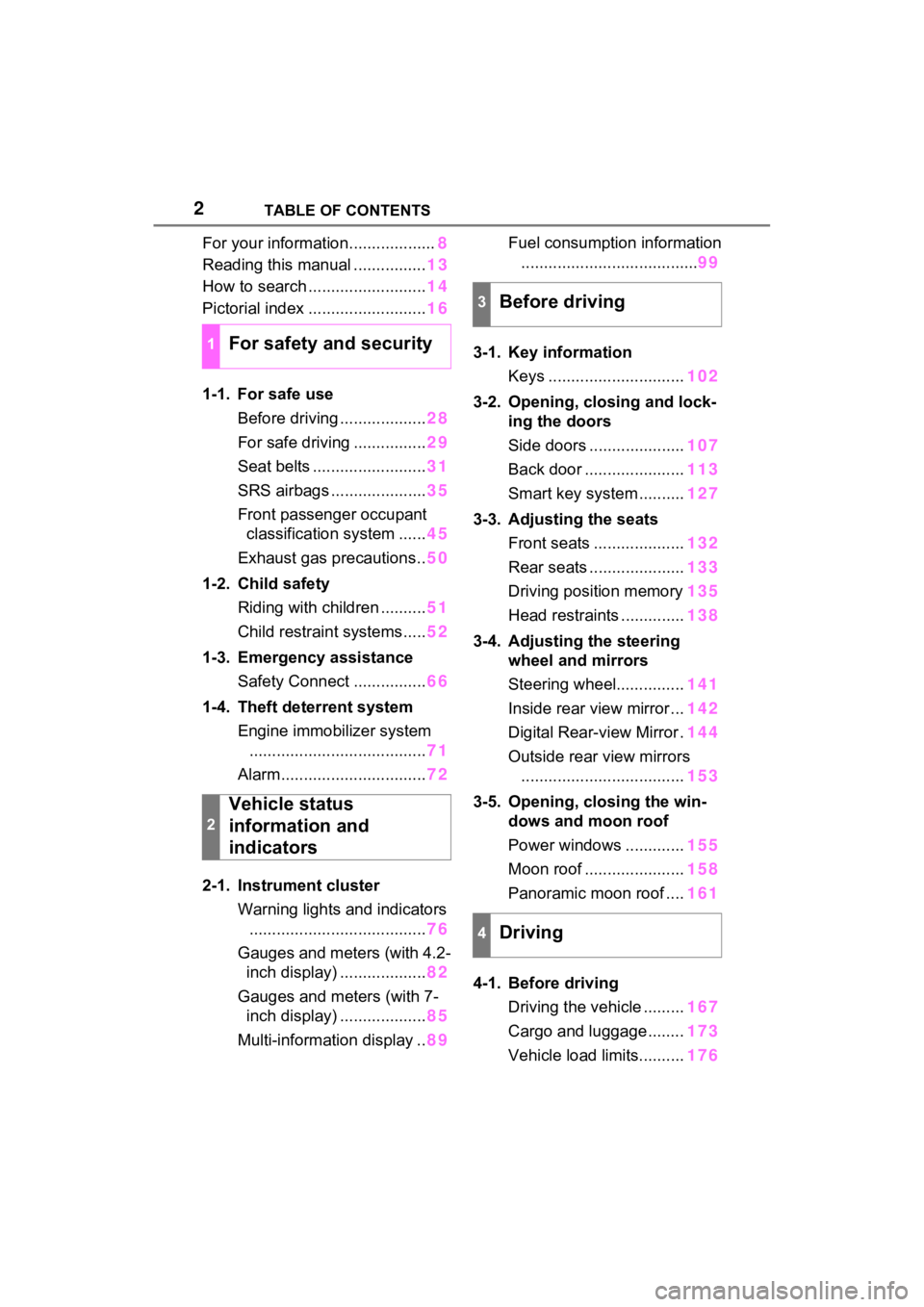
2TABLE OF CONTENTS
For your information...................8
Reading this manual ................ 13
How to search .......................... 14
Pictorial index .......................... 16
1-1. For safe use Before driving ................... 28
For safe driving ................ 29
Seat belts ......................... 31
SRS airbags ..................... 35
Front passenger occupant classification system ...... 45
Exhaust gas precautions.. 50
1-2. Child safety Riding with children .......... 51
Child restraint systems..... 52
1-3. Emergency assistance Safety Connect ................ 66
1-4. Theft deterrent system Engine immobilizer system....................................... 71
Alarm................................ 72
2-1. Instrument cluster Warning lights and indicators....................................... 76
Gauges and meters (with 4.2- inch display) ................... 82
Gauges and meters (with 7- inch display) ................... 85
Multi-information display .. 89Fuel consumption information
....................................... 99
3-1. Key information Keys .............................. 102
3-2. Opening, closing and lock- ing the doors
Side doors ..................... 107
Back door ...................... 113
Smart key system .......... 127
3-3. Adjusting the seats Front seats .................... 132
Rear seats ..................... 133
Driving position memory 135
Head restraints .............. 138
3-4. Adjusting the steering wheel and mirrors
Steering wheel............... 141
Inside rear view mirror ... 142
Digital Rear-view Mirror . 144
Outside rear view mirrors .................................... 153
3-5. Opening, closing the win- dows and moon roof
Power windows ............. 155
Moon roof ...................... 158
Panoramic moon roof .... 161
4-1. Before driving Driving the vehicle ......... 167
Cargo and luggage ........ 173
Vehicle load limits.......... 176
1For safety and security
2
Vehicle status
information and
indicators
3Before driving
4Driving
Page 3 of 748
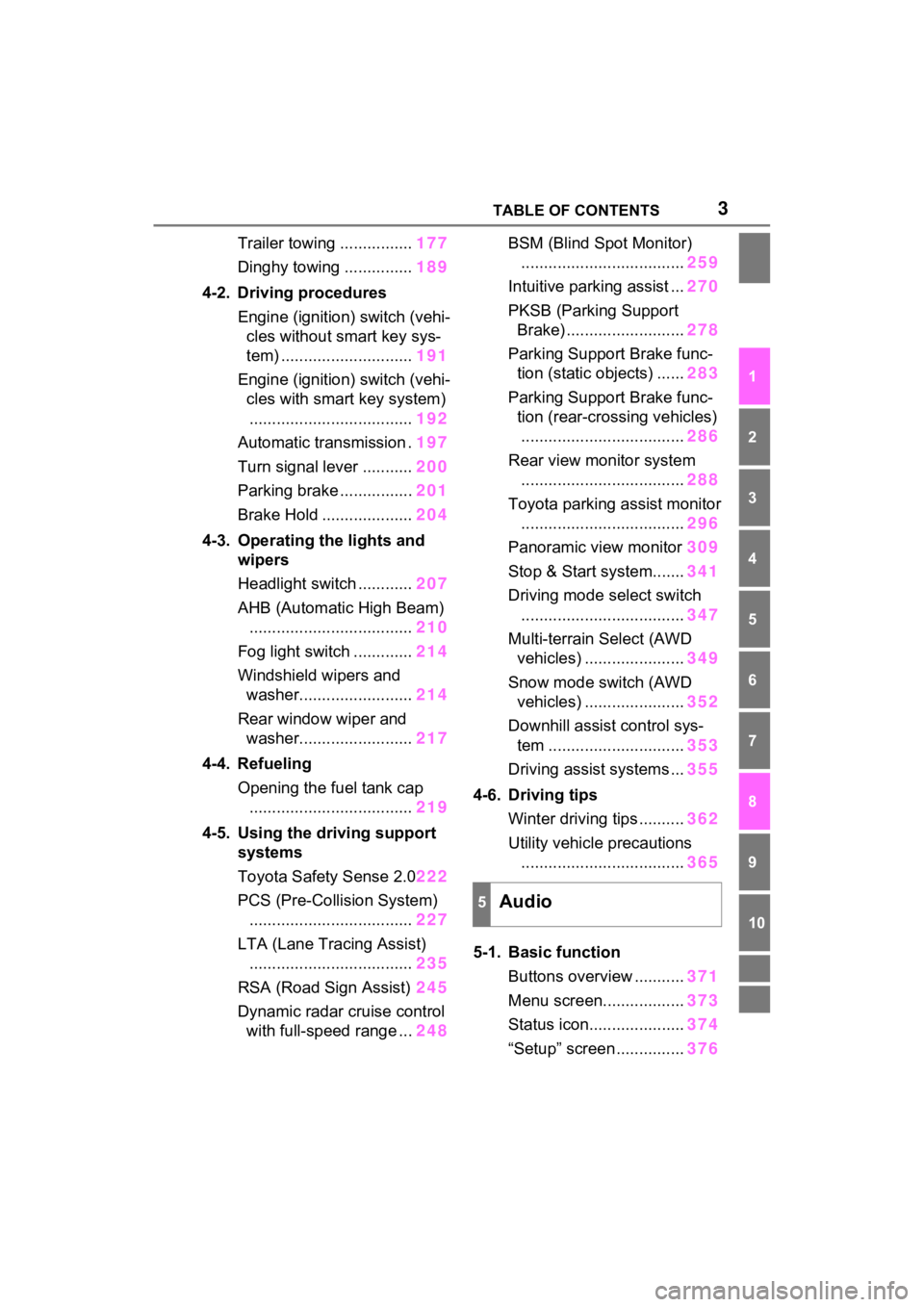
3TABLE OF CONTENTS
1
2
3
4
5
6
7
8
9
10
Trailer towing ................177
Dinghy towing ............... 189
4-2. Driving procedures Engine (ignition) switch (vehi-cles without smart key sys-
tem) ............................. 191
Engine (ignition) switch (vehi- cles with smart key system)
.................................... 192
Automatic transmission . 197
Turn signal lever ........... 200
Parking brake ................ 201
Brake Hold .................... 204
4-3. Operating the lights and wipers
Headlight switch ............ 207
AHB (Automatic High Beam) .................................... 210
Fog light switch ............. 214
Windshield wipers and washer......................... 214
Rear window wiper and washer......................... 217
4-4. Refueling Opening the fuel tank cap.................................... 219
4-5. Using the driving support
systems
Toyota Safety Sense 2.0 222
PCS (Pre-Collision System) .................................... 227
LTA (Lane Tracing Assist) .................................... 235
RSA (Road Sign Assist) 245
Dynamic radar cruise control with full-speed range ... 248BSM (Blind Spot Monitor)
.................................... 259
Intuitive parking assist ... 270
PKSB (Parking Support Brake) .......................... 278
Parking Support Brake func- tion (static objects) ...... 283
Parking Support Brake func- tion (rear-crossing vehicles)
.................................... 286
Rear view monitor system .................................... 288
Toyota parking assist monitor .................................... 296
Panoramic view monitor 309
Stop & Start system....... 341
Driving mode s elect switch
.................................... 347
Multi-terrain Select (AWD vehicles) ...................... 349
Snow mode switch (AWD vehicles) ...................... 352
Downhill assist control sys- tem .............................. 353
Driving assist systems ... 355
4-6. Driving tips Winter driving tips .......... 362
Utility vehicle precautions .... ...
............................. 365
5-1. Basic function Buttons overview ........... 371
Menu screen.................. 373
Status icon..................... 374
“Setup” screen ............... 376
5Audio
Page 5 of 748
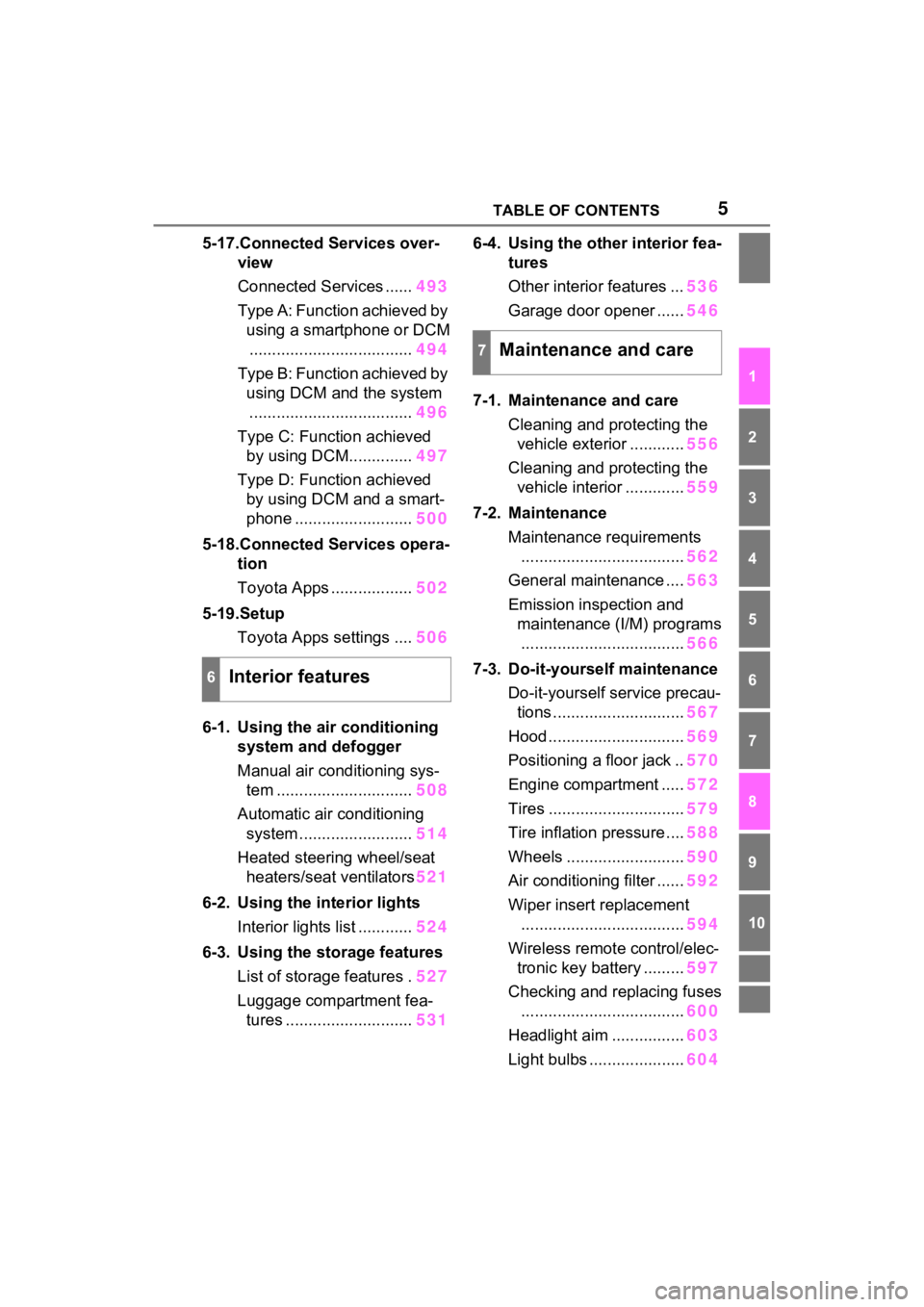
5TABLE OF CONTENTS
1
2
3
4
5
6
7
8
9
10
5-17.Connected Services over-view
Connected Services ...... 493
Type A: Function achieved by using a smartphone or DCM.................................... 494
Type B: Function achieved by using DCM and the system
.................................... 496
Type C: Function achieved by using DCM.............. 497
Type D: Function achieved by using DCM and a smart-
phone .......................... 500
5-18.Connected Services opera- tion
Toyota Apps .................. 502
5-19.Setup Toyota Apps settings .... 506
6-1. Using the air conditioning
system and defogger
Manual air conditioning sys- tem .............................. 508
Automatic air conditioning system ......................... 514
Heated steering wheel/seat heaters/seat ventilators 521
6-2. Using the interior lights Interior lights list ............ 524
6-3. Using the storage features List of storage features . 527
Luggage compartment fea- tures ............................ 5316-4. Using the other interior fea-
tures
Other interior features ... 536
Garage door opener ...... 546
7-1. Maintenance and care Cleaning and protecting the vehicle exterior ............ 556
Cleaning and protecting the vehicle interior ............. 559
7-2. Maintenance Maintenance requirements.................................... 562
General maintenance .... 563
Emission inspection and maintenance (I/M) programs.................................... 566
7-3. Do-it-yourself maintenance Do-it-yourself service precau-tions ............................. 567
Hood .............................. 569
Positioning a floor jack .. 570
Engine compartment ..... 572
Tires .............................. 579
Tire inflation pressure .... 588
Wheels .......................... 590
Air conditioning filter ...... 592
Wiper insert replacement .................................... 594
Wireless remote control/elec- tronic key battery ......... 597
Checking and replacing fuses .................................... 600
Headlight aim ................ 603
Light bulbs ..................... 604
6Interior features
7Maintenance and care
Page 6 of 748
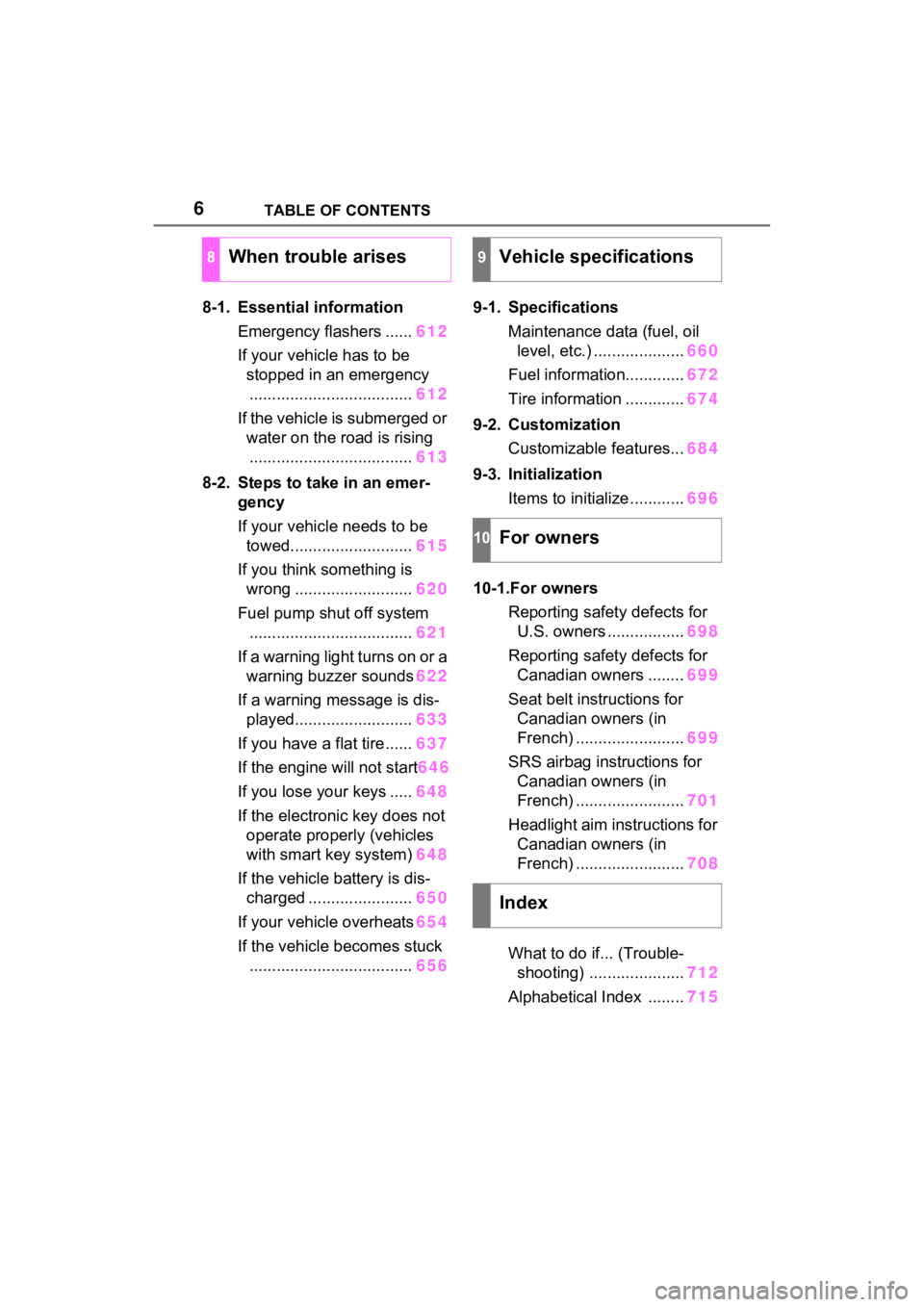
6TABLE OF CONTENTS
8-1. Essential informationEmergency flashers ...... 612
If your vehicle has to be stopped in an emergency.................................... 612
If the vehicle is submerged or water on the road is rising.................................... 613
8-2. Steps to take in an emer- gency
If your vehicle needs to be towed........................... 615
If you think something is wrong .......................... 620
Fuel pump shut off system .................................... 621
If a warning light turns on or a warning buzzer sounds 622
If a warning message is dis- played.......................... 633
If you have a flat tire...... 637
If the engine will not start 646
If you lose your keys ..... 648
If the electronic key does not operate properly (vehicles
with smart key system) 648
If the vehicle battery is dis- charged ....................... 650
If your vehicle overheats 654
If the vehicle becomes stuck .................................... 6569-1. Specifications
Maintenance data (fuel, oil level, etc.) .................... 660
Fuel information............. 672
Tire information ............. 674
9-2. Customization Customizable features... 684
9-3. Initialization Items to initialize ............ 696
10-1.For owners Reporting safet y defects for
U.S. owners ................. 698
Reporting safet y defects for
Canadian owners ........ 699
Seat belt instructions for Canadian owners (in
French) ........................ 699
SRS airbag instructions for Canadian owners (in
French) ........................ 701
Headlight aim instructions for Canadian owners (in
French) ........................ 708
What to do if... (Trouble- shooting) ..................... 712
Alphabetical Index ........ 715
8When trouble arises9Vehicle specifications
10For owners
Index
Page 12 of 748

12
WARNING
■General precautions while
driving
Driving under the influence: Never
drive your vehicle when under the
influence of alcohol or drugs that
have impaired your ability to oper-
ate your vehicle. Alcohol and cer-
tain drugs delay reaction time,
impair judgment and reduce coor-
dination, which could lead to an
accident that could result in death
or serious injury.
Defensive drivin g: Always drive
defensively. Anticipate mistakes
that other drivers or pedestrians
might make and be ready to avoid
accidents.
Driver distraction: Always give
your full attention to driving. Any-
thing that distracts the driver,
such as adjusting controls, talking
on a cellular phone or reading can
result in a collision with resulting
death or serious injury to you,
your occupant s or others.
■General precaution regarding
children’s safety
Never leave children unattended
in the vehicle, and never allow
children to have or use the key.
Children may be able to start the
vehicle or shift the vehicle into
neutral. There is also a danger
that children may injure them-
selves by playing with the side
windows, the moon roof or the
panoramic moon roof, or other
features of the vehicle. In addi-
tion, heat build-up or extremely
cold temperatures inside the vehi-
cle can be fatal to children.
Page 16 of 748
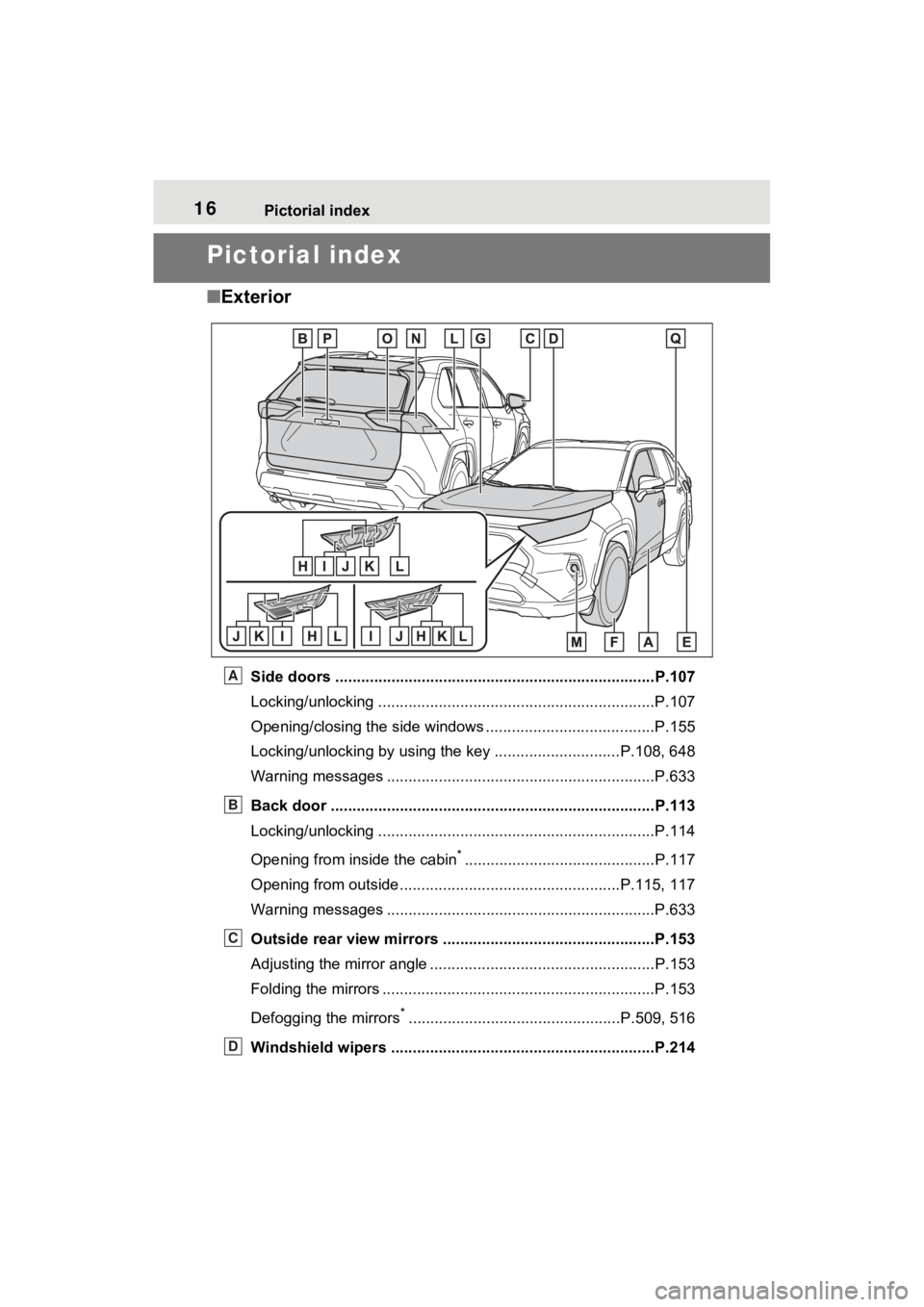
16Pictorial index
Pictorial index
■Exterior
Side doors ......... ................................. ................................P.107
Locking/unlocking ................................................................P.107
Opening/closing the side windows ............................... ........P.155
Locking/unlocking by using the key ............................. P.108, 648
Warning messages ..............................................................P.633
Back door ...................................................... .....................P.113
Locking/unlocking ................................................................P.114
Opening from inside the cabin
*............................................P.117
Opening from outside........................................... ........P.115, 117
Warning messages ..............................................................P.633
Outside rear view mirrors .................................................P.153
Adjusting the mirror angle ..................................... ...............P.153
Folding the mirrors ...............................................................P.153
Defogging the mirrors
*.................................................P.509, 516
Windshield wipers .............................................. ...............P.214
A
B
C
D
Page 43 of 748
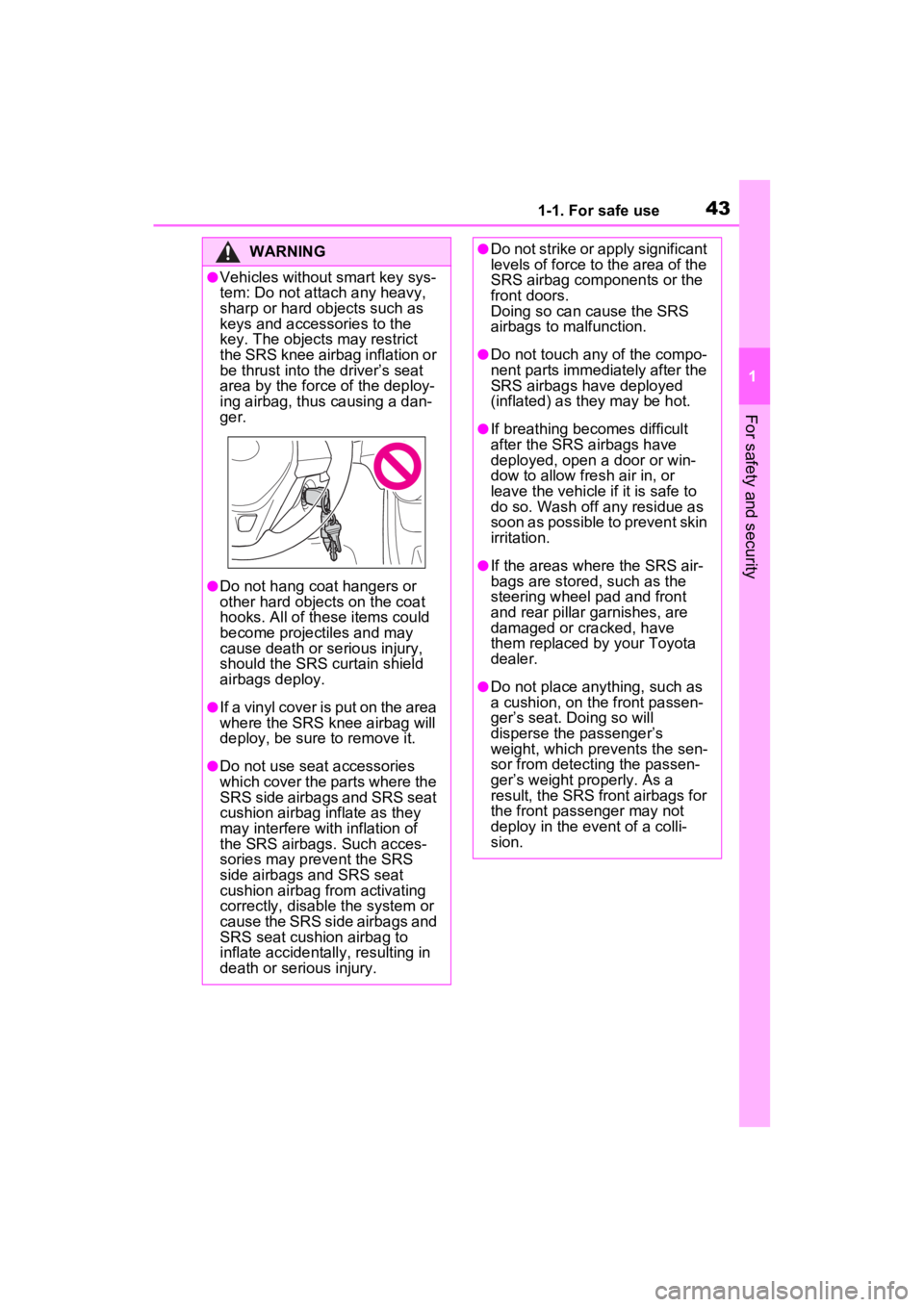
431-1. For safe use
1
For safety and security
WARNING
●Vehicles without smart key sys-
tem: Do not attach any heavy,
sharp or hard objects such as
keys and accessories to the
key. The objects may restrict
the SRS knee airbag inflation or
be thrust into the driver’s seat
area by the force of the deploy-
ing airbag, thus causing a dan-
ger.
●Do not hang coat hangers or
other hard objects on the coat
hooks. All of these items could
become projectiles and may
cause death or serious injury,
should the SRS curtain shield
airbags deploy.
●If a vinyl cover is put on the area
where the SRS knee airbag will
deploy, be sure to remove it.
●Do not use seat accessories
which cover the parts where the
SRS side airbags and SRS seat
cushion airbag inflate as they
may interfere with inflation of
the SRS airbags. Such acces-
sories may prevent the SRS
side airbags and SRS seat
cushion airbag from activating
correctly, disable the system or
cause the SRS side airbags and
SRS seat cushion airbag to
inflate accidentally, resulting in
death or serious injury.
●Do not strike or apply significant
levels of force to the area of the
SRS airbag components or the
front doors.
Doing so can cause the SRS
airbags to malfunction.
●Do not touch any of the compo-
nent parts immediately after the
SRS airbags have deployed
(inflated) as they may be hot.
●If breathing becomes difficult
after the SRS airbags have
deployed, open a door or win-
dow to allow fresh air in, or
leave the vehicle if it is safe to
do so. Wash off any residue as
soon as possible to prevent skin
irritation.
●If the areas where the SRS air-
bags are stored, such as the
steering wheel pad and front
and rear pillar garnishes, are
damaged or cracked, have
them replaced by your Toyota
dealer.
●Do not place anything, such as
a cushion, on the front passen-
ger’s seat. Doing so will
disperse the passenger’s
weight, which prevents the sen-
sor from detecting the passen-
ger’s weight properly. As a
result, the SRS front airbags for
the front passenger may not
deploy in the event of a colli-
sion.
Page 51 of 748
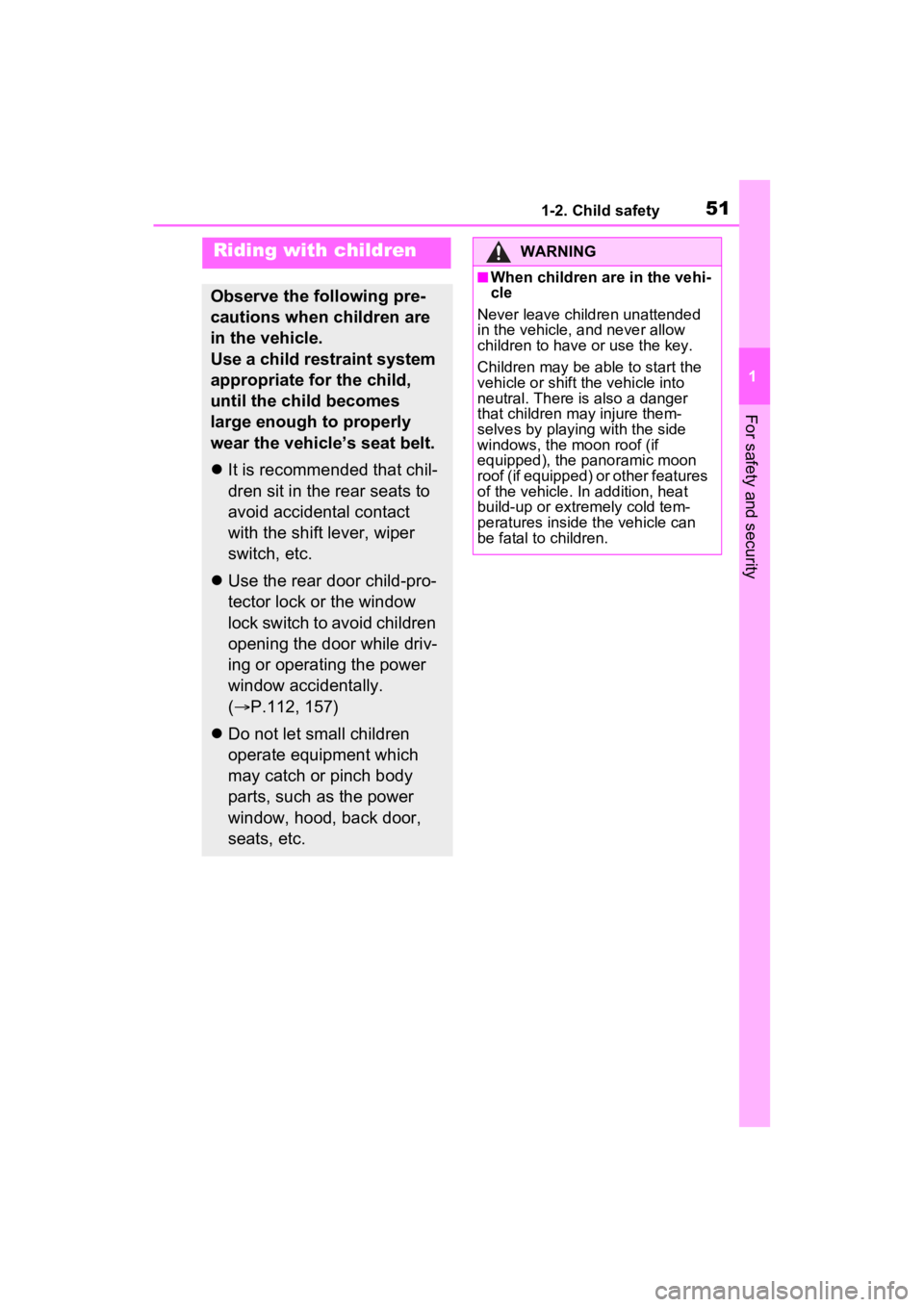
511-2. Child safety
1
For safety and security
1-2.Child safety
Riding with children
Observe the following pre-
cautions when children are
in the vehicle.
Use a child restraint system
appropriate for the child,
until the child becomes
large enough to properly
wear the vehicle’s seat belt.
It is recommended that chil-
dren sit in the rear seats to
avoid accidental contact
with the shift lever, wiper
switch, etc.
Use the rear door child-pro-
tector lock or the window
lock switch to avoid children
opening the door while driv-
ing or operating the power
window accidentally.
( P.112, 157)
Do not let small children
operate equipment which
may catch or pinch body
parts, such as the power
window, hood, back door,
seats, etc.
WARNING
■When children are in the vehi-
cle
Never leave children unattended
in the vehicle, and never allow
children to have or use the key.
Children may be able to start the
vehicle or shift the vehicle into
neutral. There is also a danger
that children ma y injure them-
selves by playing with the side
windows, the moon roof (if
equipped), the panoramic moon
roof (if equipped) or other features
of the vehicle. In addition, heat
build-up or extremely cold tem-
peratures inside the vehicle can
be fatal to children.
Page 71 of 748
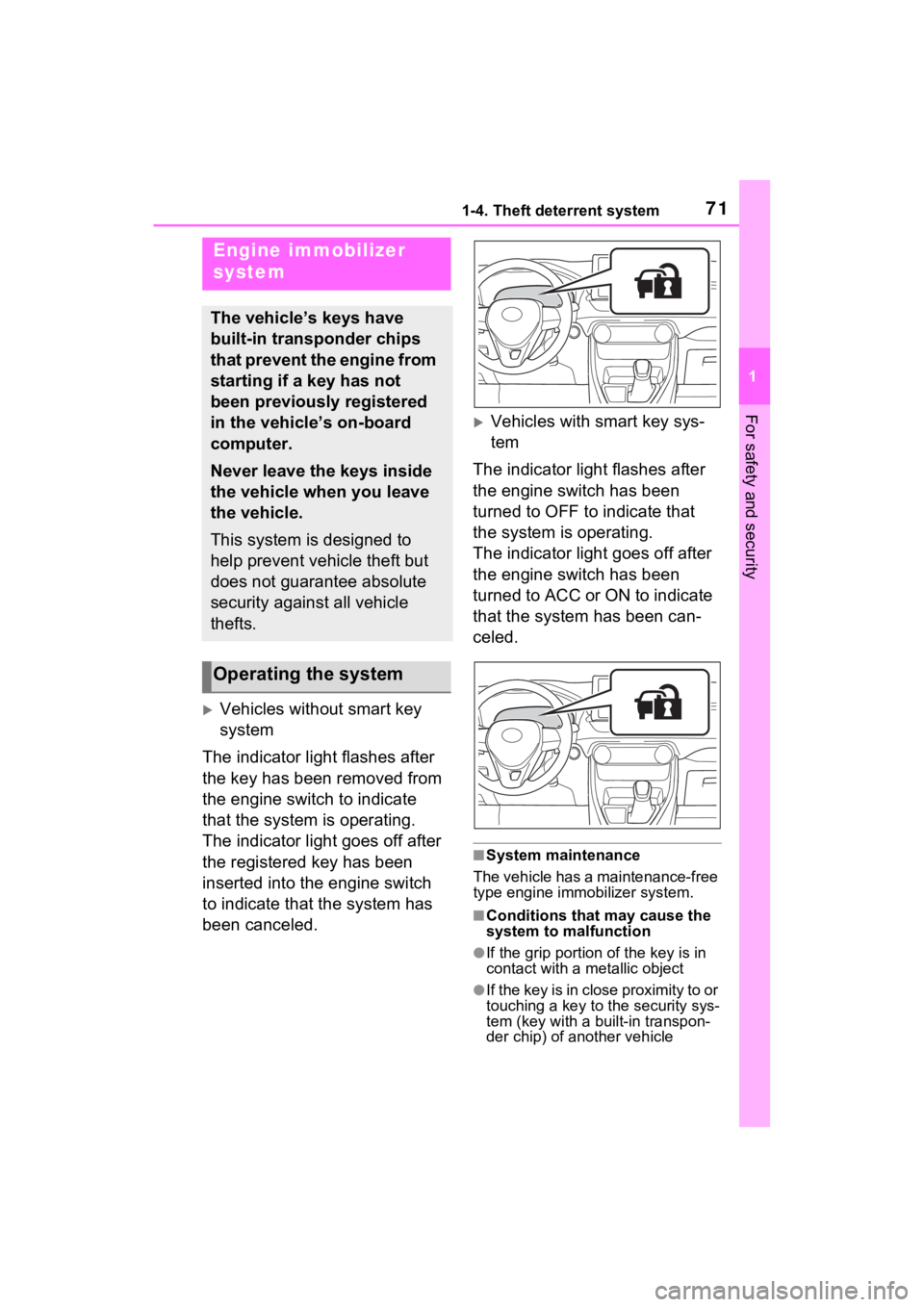
711-4. Theft deterrent system
1
For safety and security
1-4.Theft deterrent system
Vehicles without smart key
system
The indicator light flashes after
the key has been removed from
the engine switch to indicate
that the system is operating.
The indicator light goes off after
the registered key has been
inserted into the engine switch
to indicate that the system has
been canceled.
Vehicles with smart key sys-
tem
The indicator light flashes after
the engine switch has been
turned to OFF to indicate that
the system is operating.
The indicator light goes off after
the engine switch has been
turned to ACC or ON to indicate
that the system has been can-
celed.
■System maintenance
The vehicle has a maintenance-free
type engine immo bilizer system.
■Conditions that may cause the
system to malfunction
●If the grip portion of the key is in
contact with a metallic object
●If the key is in close proximity to or
touching a key to the security sys-
tem (key with a built-in transpon-
der chip) of another vehicle
Engine immobilizer
system
The vehicle’s keys have
built-in transponder chips
that prevent the engine from
starting if a key has not
been previously registered
in the vehicle’s on-board
computer.
Never leave the keys inside
the vehicle when you leave
the vehicle.
This system is designed to
help prevent vehicle theft but
does not guarantee absolute
security against all vehicle
thefts.
Operating the system